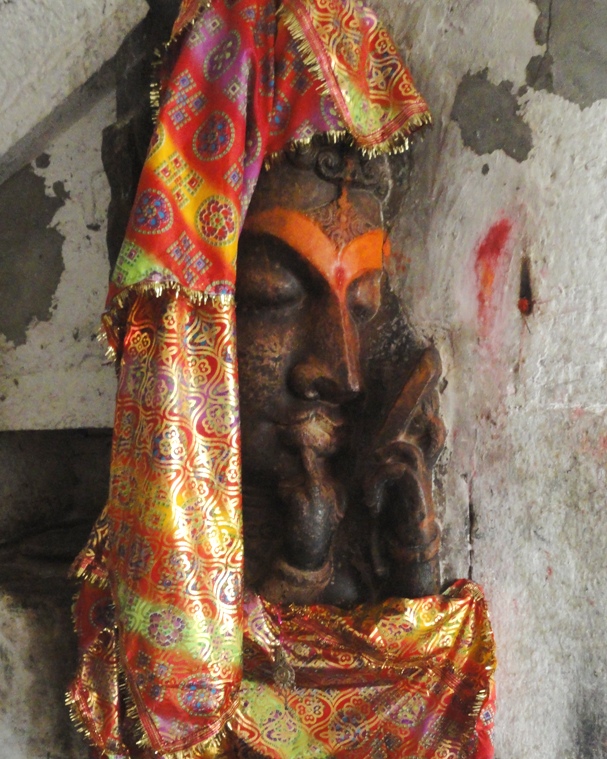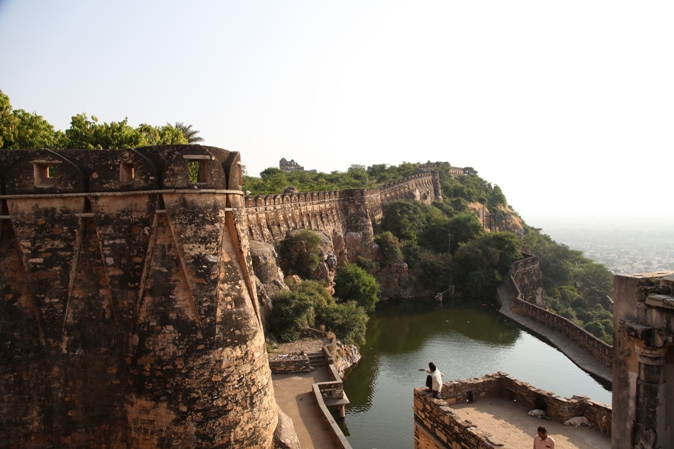In the twilight dappled ruins of a crumbling fort,
swallows roost;
And life goes on
Under my toes, the stones burn. It is as if the fire still rages in the underground vaults of Chittorgarh where the beautiful queen Padmini flung herself into the flames 700 years back, along with 1200 other women and children, preferring a painful death to disgrace. But actually, it is just the hot afternoon sun. I yearn to step back into my shoes but to visit Rani Padmini’s last haunt, you show respect by going bare feet. Inside a claustrophobic temple, etched in stone, is a portrait of a woman looking into a mirror. “That is the queen lamenting the beauty that only brought misfortune and death,” I’m told. From the corner of my eye I catch the lady sitting outside the temple shake her stick at an alarmed Saransh, my son, for not taking off his shoes. I’d love to take her home with me.
I then give undivided attention to the young man by my side. He has chased us on a wheezing old Luna (quite like a modern day horse borne Rajput warrior) as our car climbed up to the fort ramparts and has coaxed us (by fearlessly sticking his head in through our window) into hiring him as a guide.
So Rajes, as he introduces himself, is warming up to his version of Padmini’s story and quite frankly giving me goose bumps with his lethal powers of narration. He points to a short stone staircase that leads to a shimmering pool of water and then winds down under a crumbling stone arch, disappearing into the darkness underneath. Visitors are not allowed in, he tells me. Wild horses couldn’t drag me there. That is the path leading to the cellars where pyres of burning sandalwood were lit into which cauldrons of ghee were poured to make the flames dance and touch the roof. And then to the blowing of the conch, queen Padmini jumped into the flames, dressed in her wedding finery, looking breathtakingly beautiful, just the way she had done on the day she came to the king – Rawal Ratan Singh – as his young bride. I listen spellbound as Rajes takes me back 700 years to the time when Allauddin Khilji, the king of Delhi, hearing of Padmini’s legendary beauty from a wandering musician, laid seige to the fort of Chittorgarh, demanding her for his harem. “Six months had passed, the food had finished and children were crying for milk,” Rajes tells me. So when Khilji made an offer to withdraw his forces if he was allowed to see Padmini just once, Rawal Ratan Singh agreed. Khilji was blindfolded and brought in on the condition that he would only be allowed to see Padmini in a mirror.
Rajes walks me to Padmini’s palace that stands in the centre of a pond where lotus flowers once bloomed (so he says) but now only murky water stagnates. Saransh, who is noisily emptying a coconut through a straw, has also fallen under the spell of the master story teller and scampers along. Rajes points out the steps of the palace where Padmini sat with a delicate veil covering her face and then lifted it for a fraction of a second so that Khilji could see her face in a mirror fixed in the palace across the water.
He has us follow him to the spot where Khilji stood and we take turns at looking into a cheap mirror fixed on the crumbling wall that reflects the steps of Padmini’s palace. She was so beautiful that Khilji forgot his promise and when Ratan Singh escorted him out of the fort he had him captured and threatened to kill him unless Padmini was handed over. The queen, who was as intelligent as she was beautiful asked for 700 palanquins for her maids and when the palanquins returned, out jumped armed soldiers who managed to rescue their king. Khilji refused to lift the seige and finally the gates of Chittorgarh had to be opened for a final suicidal battle.
“After the women had jumped into the fire, pushing their children into the flames before them, the men took off their armour, smeared their bodies with chandan, put flaming red tilaks on their foreheads and donned the kesariya robes of martyrdom. They stoically watched this ritual of death called jauhar and then sealed the women and children in even as their screams rent the air. Then with ash smeared on their foreheads, they got on their horses and rode down the stone path as the seven gates of Chittorgarh were flung open one by one. The outnumbered warriors fought until death, knowing they had nothing left to return to,” says Rajes his voice dropping to an emotional whisper. Through the chatter of tourists, the call of the bhelpuri wallah and the clink of a bottle opener hitting cold drink bottles, I can hear the trot of horse hooves, the sizzle of orange flames, the war cries of the warriors and the clash of naked swords. Rajes has, meanwhile devoured half a Pepsi in one large gulp and after a delicate burp got on with his story. “After every single man in the Rawal’s Army was massacred, the victorious Khilji, known for his cruelty, rode his elephant into the fort but all he found was a ghost town with barren halls and temples enveloped in the fumes of burning sandalwood. Driven to a mad rage, he ordered his soldier to loot and plunder and destroy everything in sight. The exquisitely carved stones figures on Chittorgarh’s walls are evidence of the ruthless fury unleashed. They stare silently with gorged out eyes, snipped off limbs and mutilated bodies.
The saga of Chittorgarh is the most poignantly romantic story that Rajasthan offers tourists but there are more. This is the same fort where Mira refused to commit sati on the death of her husband, proclaiming that she was married to Krishna; where a few hundred years later Rani Karmavati also committed jauhar when Sher Shah of Gujarat attacked the fort and though she sent a rakhi to the Mughal emperor Humayun, he could not reach in time to help her out. This is also where Panna dai, foster mother of Rana Sangha’s infant son Udai Singh, saved the future king of Mewar, by placing her son in Udai Singh’s bed when she learnt that a murderous attack was being planned on the child at night. These stories have been kept alive by bards and folk performers and local guides like Rajes.
As we leave Chittorgarh, the sun is setting and the ruins are changing colour from yellow to orange to grey. I am ticked off by Rajes for not buying the special Sita phal sari at the fort emporium on which he would have received a two percent commission. Husband slips him an extra tip to make up and we wave to him as he slips on his hideous helmet and zips away on the Luna, finally disappearing in the rear view mirror. Husband has slipped in a CD he has picked up and a gravelly Rajasthani folk singer’s voice fills the air. In the distance the massive ramparts of the fort are gradually getting smaller. I look at the cleft in the hills from where Rajes has told us Khilji’s Army poured in like colonies of ants – slowly surrounding Chittorgarh with thousands of men, weapons, horses and elephants. A shiver runs down my spine. “I want to go home,” whines the kid from the back seat. For once, so do I.
Rachna Bisht-Rawat is a journalist and writer. She is also mom to a nine-year-old and gypsy wife to an Army officer whose work takes the Rawats to some of the most remote corners of India. You can read her blog at rachnabisht.com







